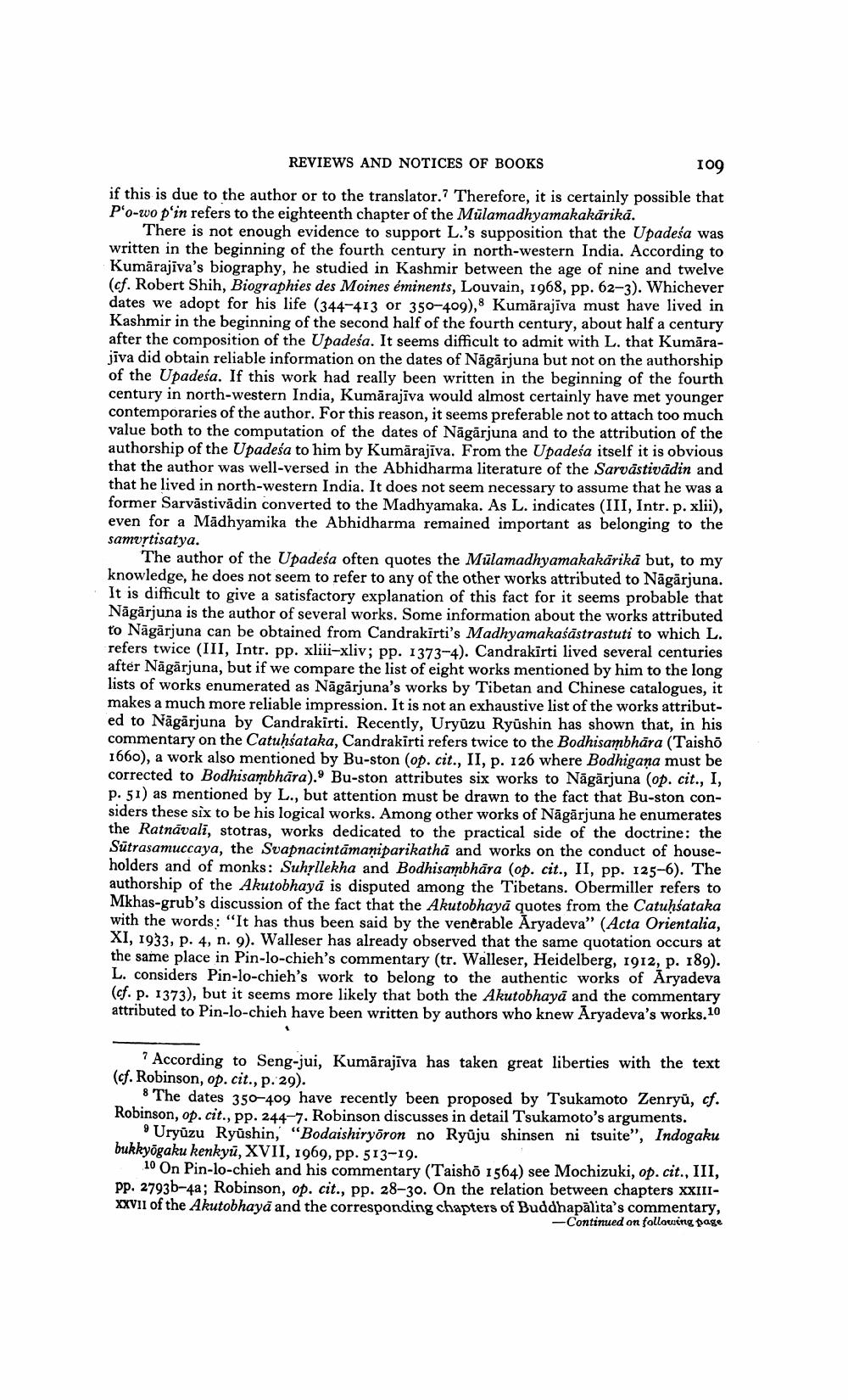________________
REVIEWS AND NOTICES OF BOOKS
109
if this is due to the author or to the translator. Therefore, it is certainly possible that P'o-wo p'in refers to the eighteenth chapter of the Mülamadhyamakakārika.
There is not enough evidence to support Li's supposition that the Upadeśa was written in the beginning of the fourth century in north-western India. According to Kumārajiva's biography, he studied in Kashmir between the age of nine and twelve (cf. Robert Shih, Biographies des Moines éminents, Louvain, 1968, pp. 62-3). Whichever dates we adopt for his life (344-413 or 350-409), Kumārajīva must have lived in Kashmir in the beginning of the second half of the fourth century, about half a century after the composition of the Upadeśa. It seems difficult to admit with L. that Kumārajiva did obtain reliable information on the dates of Nagarjuna but not on the authorship of the Upadeśa. If this work had really been written in the beginning of the fourth century in north-western India, Kumārajīva would almost certainly have met younger contemporaries of the author. For this reason, it seems preferable not to attach too much value both to the computation of the dates of Nāgārjuna and to the attribution of the authorship of the Upadeśa to him by Kumārajīva. From the Upadeśa itself it is obvious that the author was well-versed in the Abhidharma literature of the Sarvāstivādin and that he lived in north-western India. It does not seem necessary to assume that he was a former Sarvästivādin converted to the Madhyamaka. As L. indicates (III, Intr. p. xlii), even for a Mādhyamika the Abhidharma remained important as belonging to the samortisatya.
The author of the Upadeśa often quotes the Mülamadhyamakakārikā but, to my knowledge, he does not seem to refer to any of the other works attributed to Nāgārjuna. It is difficult to give a satisfactory explanation of this fact for it seems probable that Nāgārjuna is the author of several works. Some information about the works attributed to Nāgārjuna can be obtained from Candrakirti's Madhyamakaśāstrastuti to which L. refers twice (III, Intr. pp. xliii-xliv; pp. 1373-4). Candrakirti lived several centuries after Nāgārjuna, but if we compare the list of eight works mentioned by him to the long lists of works enumerated as Nāgārjuna's works by Tibetan and Chinese catalogues, it makes a much more reliable impression. It is not an exhaustive list of the works attributed to Nāgārjuna by Candrakirti. Recently, Uryûzu Ryushin has shown that, in his commentary on the Catuhsataka, Candrakirti refers twice to the Bodhisambhāra (Taisho 1660), a work also mentioned by Bu-ston (op. cit., II, p. 126 where Bodhigana must be corrected to Bodhisambhāra).' Bu-ston attributes six works to Nāgärjuna (op. cit., I, p. 51) as mentioned by L., but attention must be drawn to the fact that Bu-ston considers these six to be his logical works. Among other works of Nāgārjuna he enumerates the Ratnávali, stotras, works dedicated to the practical side of the doctrine: the Sūtrasamuccaya, the Swapnacintāmani parikatha and works on the conduct of householders and of monks: Suhrllekha and Bodhisambhāra (op. cit., II, pp. 125-6). The authorship of the Akutobhayā is disputed among the Tibetans. Obermiller refers to Mkhas-grub's discussion of the fact that the Akutobhayā quotes from the Catuḥśataka with the words: "It has thus been said by the venerable Aryadeva" (Acta Orientalia, XI, 1933, p. 4, n. 9). Walleser has already observed that the same quotation occurs at the same place in Pin-lo-chieh's commentary (tr. Walleser, Heidelberg, 1912, p. 189). L. considers Pin-lo-chieh's work to belong to the authentic works of Aryadeva (cf. p. 1373), but it seems more likely that both the Akutobhayā and the commentary attributed to Pin-lo-chieh have been written by authors who knew Aryadeva's works.10
? According to Seng-jui, Kumārajiva has taken great liberties with the text (cf. Robinson, op. cit., p. 29).
8 The dates 350-409 have recently been proposed by Tsukamoto Zenryü, cf. Robinson, op. cit., pp. 244-7. Robinson discusses in detail Tsukamoto's arguments.
Uryûzu Ryūshin, "Bodaishiryoron no Ryūju shinsen ni tsuite", Indogaku bukkyōgaku kenkyū, XVII, 1969, pp. 513-19.
10 On Pin-lo-chieh and his commentary (Taisho 1564) see Mochizuki, op. cit., III, Pp. 2793b-4a; Robinson, op. cit., pp. 28-30. On the relation between chapters XXIIIXXVII of the Akutobhayā and the corresponding chapters of Buddhapalita's commentary,
-Continued on following page




